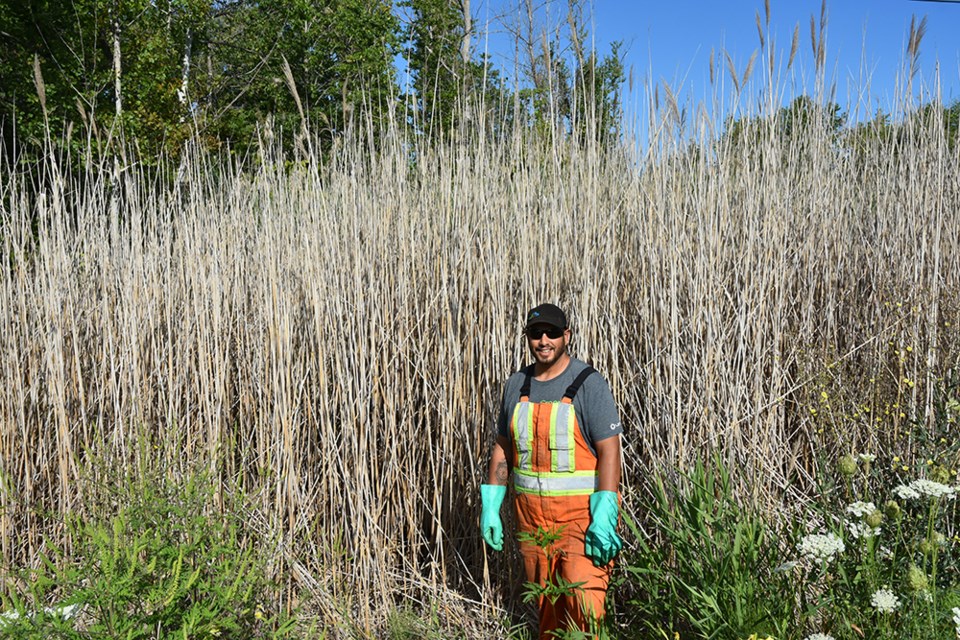Ghostly stands of Phragmites australis, the invasive Common Reed, stand along roadsides in Innisfil.
The dead stands show where last year’s controlled spraying was carried out, part of a three-year pilot project undertaken by the Town of Innisfil and County of Simcoe, targeting the invasive threat.
Phragmites australis is native to Eurasia. It can form dense stands nearly five metres in height that choke out other plant species, threatening the biodiversity of wetlands. It has been spreading in Ontario, almost without check.
Several years ago, Innisfil staff began mapping the location of stands of Phragmites along 460 lane kilometres of county and municipal roads. Last year, the town and the county received permission to undertake a pilot project, spraying Phragmites found on the road allowances with a glyphosate-based herbicide.
This is Year 2 of the pilot. Work was delayed due to uncertain weather conditions, but on Aug. 14 the licenced contractor began returning to locations targeted last year, as well as any new growth spotted by Innisfil staff.
What he found was that patches of Phragmites sprayed last year had not come back.
“He was impressed by how well it worked,” said Jeremy Nyenhuis, stormwater project manager for the Town of Innisfil. There was no regrowth within the patches, except along the margins and on adjacent private lands, where the contractor was not permitted to spray.
“It’s working,” said Nyenhuis.
The project was the result of work carried out by Innisfil’s Strategic Leader-Operations Jason Inwood, who launched an awareness campaign of the threats posed by Phragmites.
Easily spreading by both rhizomes (roots) and seeds, Phragmites can clog ditches and storm drainage ponds, take over natural wetlands, and invade agricultural lands. The tall reeds can block sightlines at intersections, resulting in dangerous conditions for motorists.
And in areas with shorelines, as along Georgian Bay, stands of Phragmites can interfere with the enjoyment of the waterfront, with wildlife, and with tourism.
It’s not something that Inwood wanted to see happen along the shores of Lake Simcoe.
He contacted other municipalities, and the Premier of Ontario, hoping to bring the issue to their attention. And with so many stands of Phragmites spotted on county roads, Inwood also contacted Simcoe County.
“In order to do things properly, we needed to engage them,” explained Nyenhuis.
The town and the county are now partners in the pilot project, splitting the cost of the spraying and monitoring.
There has been some pushback from residents, over the use of a glyphosate-based pesticide. Nyenhuis acknowledged that when notification of the spraying was published in a local newspaper, “a lot of residents were inquiring about it – mostly location and timing.”
However, he noted, “For the amount we spray, at the rate we spray, it’s very minimal.” Although the contractor is traversing 460 lane kilometres, he is “only applying where the plant is,” said Nyenhuis. “It’s very site specific.”
There are also restrictions on where spraying can and can’t take place, which means that some stands continue to spread.
“A lot of those are on private property,” said Nyenhuis.
The pesticide treatment is limited to road allowances and public lands. The contractor cannot spray near parks, in the vicinity of schools or construction zones – or where there is standing water.
That was proving to be an issue this year. A wetter spring and recent heavy rains have resulted in higher water levels in Lake Simcoe and the surrounding ditches and wetlands.
Areas that were high and dry last year were wet this year and had to be passed by – including the road edges near Big Cedar swamp in Belle Ewart.
“It was dry last year when I sprayed,” said contractor Robin Egan, as he drove past dead stands of Phragmites. “It’s high this year.”
He spotted some isolated new plants, in standing water – noting their location, for possible spraying next year.
Currently, control of Phragmites in wetlands and in standing water involves cutting and ‘wicking,’ Nyenhuis explained.
He described the process: cutting the top of the reed and bagging the seeds for disposal, then using an eyedropper to drop glyphosate into the exposed hollow tube of each reed.
“We may do it in the pond at the Town Hall,” he said, where Phragmites have “exploded” this year. But the Town is hoping that by spraying along roadsides, and by adopting “clean equipment” protocols for its road equipment, Innisfil can keep Phragmites out of wetlands and shorelines.
Residents may find the spraying more noticeable this year – even though there is less actual application of the herbicide. Although the town, by publishing the notification of spraying in a public newspaper, wasn’t constrained to post the areas treated, comments from residents last year have led to more signage.
Wherever Phragmites has been sprayed with glyphosate, along roadsides in residential areas, the contractor will post a warning sign.
The spraying was quickly completed in just days and information on the patches of Phragmites was updated.
Next year will be the final year of the pilot project, when the contractor will be going back for one more round, to see if the patches have been truly eradicated, or if they require on-going pesticide use.
What happens after Year 3? “That’s a great question,” said Nyenhuis. “I hope we can definitely look at the results and see if we need to redo it. I don’t think this is the end. I think we need to stay on it, so this doesn’t become a huge problem.”



